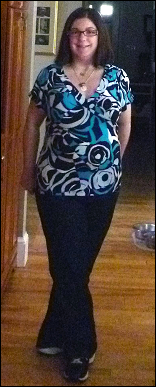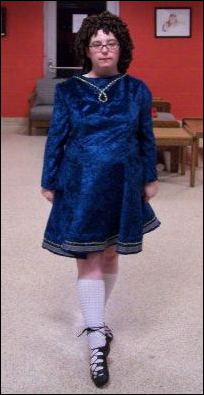Irish Step Dance
By Rachel, age 26, Connecticut

Traditional Irish step dance is very different from RiverDance. Traditional Irish step dance is a dance form which not many people know much about. I had never heard of Irish step dance until I was 15 years old and went to Michigan to visit my cousins. One of my cousins was taking Irish step dance classes for fun at college. Watching my cousin dance I decided that I wanted to try the sport.
Upon my return home from Michigan, I began researching Irish step dance schools and academies in my area. I found the Spirited Soles Academy of Irish Dance. I began in September 2000 at the age of 15 years old, and by the end of the first class I was in love. From my first class my first dance teacher could not believe that I had never danced Irish step before because from day one I excelled in Irish dance.

I have now been dancing for 10 years and still love to dance as much, if not more, than I did in the beginning. I have been dancing since 2004 off and on with The Gray School Of Irish Dance in Connecticut, and there is no other school that I would rather be with. I have been a competitive Irish step dancer since June 2001 and I am currently at Novice/Prizewinner level. I intend to begin competing again soon. I thought I would share my passion with all of you so that you can learn just a little bit about the sport which to me is my life. There is so much information that I want to share with all of you about Irish dance but I will stick with the basics. To learn about the history of Irish dance and learn why we keep our arms straight and down at our sides, check out these links:
http://www.antoniopacelli.com/cgi-bin/publisher/search.cgi?ID=1713-9101-32240&template=template.htm&dir=news
http://www.antoniopacelli.com/cgi-bin/publisher/search.cgi?ID=1255-5104-82809&template=template.htm&dir=news
Let's start with some basic terminology.
A.D.C.R.G. Certified Adjudicator: "Ard Diploma Choimisiuin Le Rinci Gaelacha" is translated "Highest Diploma in Gaelic Dancing." (see also T.C.R.G.) This is the diploma and title needed to teach Irish step dance and to run a school or academy.
T.C.R.G. (Certified Instructor): "Teasgicoir Choimisiuin Le Rinci Gaelacha." The translation is "Gaelic Commission Dancing Teacher."
So now that you know what kind of a teacher to look for if you are interested in Irish step dance, let's move on to the levels of Irish dance, which are:
Beginner: A dancer who is just starting out in Irish step dance.
Advanced Beginner
Novice
Prizewinner
Open Prizewinner
Championships
Open Championships
To move up to the next level you must attend and place in a competition which is called a feis. (feis is pronounced as 'fesh' not 'fice') Feis is simply Gaelic for 'competition.'
Oireachtas (pronounced 'oh-ROCK-tus'): A type of "super feis." In North America, they are organized by regions, having begun in 1976. Competition is by age, category, and gender, but there is no separation of skill levels. Dancers placing highly qualify for the World Championship in Ireland (Oireachtas na Cruinne). A North American championship competition began in 1969. Locations vary from year to year. Both the national and world championships are also called Oireachtas (plural is Oireachtasai).

Ghillies (soft shoe): The name of the soft shoes is pronounced 'Gil-Eees'. These are the name for the standard soft shoe worn by women dancers. They are distinctive in appearance, lacing-up from near the toe to up and around the ankle and lower leg. Ghillies are used for all the light dances such as the reel, light jig, slip jig, and single jig. In addition, light shoes are normally worn for figure dancing.
Hard Shoe: These shoes consist of fiberglass, composite, or steel tips and heels. The tips and heels are used to make a rhythmic drumming sound when performing hornpipes, hard jigs, sets, and treble reels. Irish step dancing is currently recognized through primarily hard shoe, professional performance shows like RiverDance and Lord of the Dance. However, dances with hard shoes are more difficult to perform and are thus reserved for later when the dancer gains the more basic steps.
So you dance either in soft shoes or hard shoes. Now let's move on to the dances themselves. Let's start with the most basic dance which is danced in ghillies and called the jig.
There are many references to the jig in ancient Ireland. A number of variations of the jig are performed, including the light, single (or soft), double (aka treble or hard), and slip jig. The music is 6/8 time (the emphasis on beats in a jig is: ONE-two-three four-five-six).
After you learn the jig you learn the reel.
The reel originated around 1750 in Scotland, and the Irish dance masters brought it to full development. The music is 4/4 time and it is danced at a relatively fast tempo (ONE-two-three-four). Both men and women dance the reel. For women, it is a light, rapid soft shoe dance that allows for plenty of leaping and demands an energetic performance from the dancer. Men often dance the reel in what appears to be hard shoes without the toe tap up front.
The last soft shoe dance you will learn is the slip jig.
Slip jigs are in 9/8 time (ONE-two-three four-five-six seven-eight-nine). The slip jig is danced in soft shoes and is the most graceful of Irish dances. It features light hopping, sliding, skipping, and pointing.
Once you are at the level of Novice dancer you will learn the hard shoe dances, which are:
The Hornpipe, which was originally danced exclusively by males in hard shoes, but now both men and women compete. The hornpipe is in 4/4 time, reminiscent of a slow reel with accents on the first and third beat (ONE-and-a two-and-a three-and-a four-and-a). The apparent slowness of the music allows for many intricate dance elements in a short amount of time. A notable feature is the frequent use of a rocking motion with the ankles.
The treble jig has a slower tempo, but dancers triple beats in hard shoes.
There are also set dances.
Ceili (pronounced 'kay-lee') is a gathering for music and dance. The Gaelic League sponsored the first Irish ceili in 1897. They borrowed the idea from the Scots and a precedent was set that a piper opened the ceili. Because the ceili dance revival was not widespread at that time, the dances at the first Irish ceili consisted of group set dances.
When competing in the beginning, a skirt and blouse are sufficient, but as you rise up through the levels, if you are a female, you are greatly encouraged to purchase a solo dress, which can be very simple like mine or can be much more elaborate and decorative. Solo dresses, simple or detailed, can be very pricey, but they are a worthwhile investment if you plan to dance long term.
Also, it is very common in Irish dance to wear a wig, which is Shirley Temple-like. The curled hair is part of the history of Irish dance. Some dancers do curl their natural hair, but it is a lengthy process. Wigs nowadays are the norm.
Entering your first feis
Entering your first feis is exhilarating and is an experience you will never forget. Once at a feis you will pick up your number and then you should find the stage(s) you will be dancing on. Once you locate your stage stay nearby. Once the number of your dance is called (a light jig might be #148) you will line up at the back of the stage. Remember to turn out and SMILE.
When the music begins dancers will move to the stage and dance two at a time. You may be paired with a dancer from your school or academy, but more than likely the dancer will be from another school. Do not watch the dancer you are paired with because they will have different steps. Dance two of your steps for that dance. When you complete your two steps turn out and bow to the judges and to the musician and then resume your position in line at the back of the stage. Stay in line with your feet turned out until everyone in your division has danced.
Once all the dancers have dancers have danced their two steps and are all back in line, you will all bow and the judge(s) will nod to dismiss all of you from your stage. Once you are dismissed, have some water and something light to eat. Try to eat protein. If you are dancing more than one dance find your next stage and begin the process of lining up again. After you have finished competing in each of your dances sit down and take some time to breathe, drink some water, and have clothes to change into so that you are not wearing your solo dress when you don't have to.
Then you wait for the results. The results will be posted by the initials of the dance (LJ, SJ, R, TJ, HP) and your competitor number. The results are usually posted on a large board. Results can be posted anywhere from 10 minutes to an hour or two after you finish dancing. Go and check the board(s) regularly. Once you find out whether you have placed, go pick up your medal or your trophy. If you haven't placed, don't feel bad, and remember that you are dancing for the love of it and you are a winner no matter what.
The best part of Irish dance is the places I have gotten to travel to. I have been to 32 out of 50 states competing at feisanna and I have made lifelong friends.
Information from:
Antoniopacelli.com





